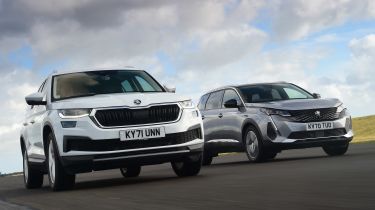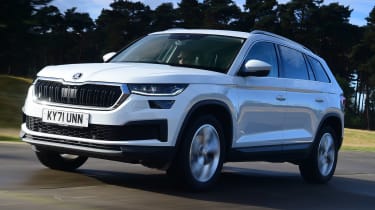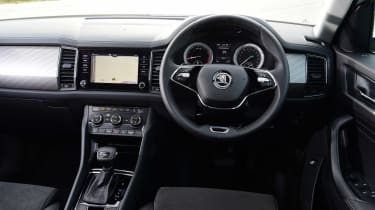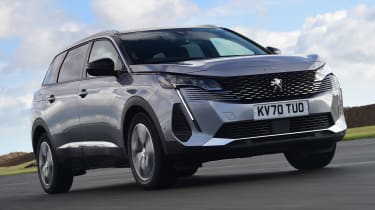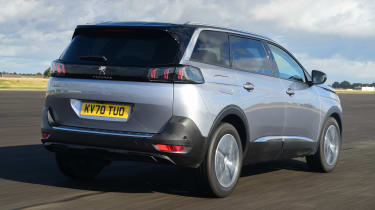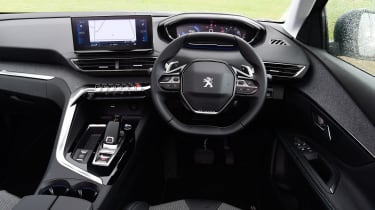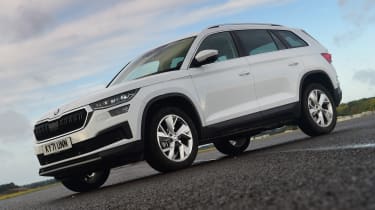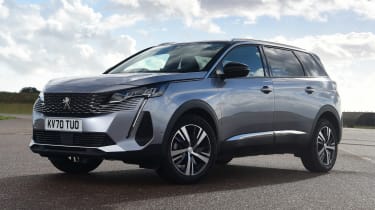Skoda Kodiaq vs Peugeot 5008: 2022 twin test review
Updates to the Skoda Kodiaq and Peugeot 5008 boost their appeal. We pick our family favourite
Seven-seaters: first and foremost, they have to perform the everyday tasks that life will throw at them with ease. If they’re sensible, tough and well thought out, you should hardly notice them going about their business; they should just slot into the family like a great sofa or a practical kitchen.
But usability doesn’t have to compromise style. When the seven-seater trend moved away from MPVs and towards SUVs, desirability improved significantly, and here we have two of the best of the breed. They’re both fresh with recent mid-life updates, and the Skoda Kodiaq is as dependable as they come. We’ve often ranked it among the best in the class since it first hit the road, and with good reason – it gets the fundamentals so very right.
But the same can be said of its challenger here, the Peugeot 5008. It’s not short on space or clever touches, and proves that a sensible seven-seater can carry off a little flair, too.
The question is, whose updates are the most significant? Will either of these cars claim their spot at the top of the class thanks to their improvements?
Skoda Kodiaq
| Model: | Skoda Kodiaq 1.5 TSI SE L Executive |
| Price: | £35,575 |
| Engine: | 1.5-litre 4cyl turbo, 148bhp |
| 0-62mph: | 9.8 seconds |
| Test economy: | 37.0mpg/8.1mpl |
| CO2: | 158g/km |
| Annual road tax: | £155 |
While the car in our pictures is in SE L trim, this has since been superseded by the SE L Executive, although the former is still available from stock. At £35,575, the Executive costs £870 more than the outgoing SE L, but that price hike is easily offset by a more generous kit list that includes standard leather upholstery, an electrically adjustable driver’s seat and a reversing camera.
Used - available now

2020 Jaguar
F-Pace
31,770 milesAutomaticDiesel3.0L
Cash £25,890
2024 Peugeot
5008
40,906 milesAutomaticDiesel1.5L
Cash £20,197
2023 Ford
Focus
14,538 milesManualPetrol1.0L
Cash £17,087
2023 Jaguar
E-PACE
20,181 milesAutomaticDiesel2.0L
Cash £24,287Design & engineering
Since the Kodiaq has been around since 2016, Skoda saw fit to introduce a subtle list of mid-life upgrades to the range towards the end of last year. Up front, there’s a more upright grille design, a new bonnet and slimmer headlights, and high-end trims can now be equipped with matrix LED headlights. Minor reprofiling of the bumpers and a new rear spoiler – which sits above tail-lights with revised graphics – are claimed to slightly improve aerodynamic efficiency, too.
Inside, the cabin looks similar to before. A new two-spoke steering wheel, first seen on the latest Octavia, is the most significant change, and that leaves the rest of the cabin feeling solid and ergonomically sound, if not quite as contemporary as its rival in this contest. There are, however, chunky physical dials for the climate control functions, and a comfortable driving position is easy to find because both that new wheel and the driver’s seat have a wide range of adjustment.
The Kodiaq’s engine line-up comes with two units that make 148bhp – one petrol and one diesel – plus a 187bhp petrol and 197bhp diesel, the latter also boasting a hefty 400Nm of torque. The range is topped by the vRS; the facelift saw this model swap diesel power for petrol, with a total output of 242bhp.
Passive dampers are standard throughout the range, but four-wheel-drive models can be equipped with an adaptive set-up. This transmission is standard on the most potent petrol and diesel models, and the 148bhp diesel offers it as an option, but the 1.5 TSI petrol tested here is front-wheel drive only.
Driving
If ever there was one car that could be championed for so seamlessly slotting into everyday life, it would be the Kodiaq. There is no one outstanding quality to the way that it drives, but it’s very competent in every area.
The priority, as it should be for a car such as this, is comfort. The Skoda moves along the road with a relaxed gait, and does a sound job of isolating bumps from the occupants inside. It manages to achieve this while still maintaining a flatter attitude through the corners than the 5008, too. This doesn’t just mean it behaves more predictably for the driver, but the reduced body movement also makes it feel more settled for passengers.
The 1.5-litre turbocharged petrol engine is similarly dependable. It produces 20Nm more torque than the Peugeot, at 250Nm, and that maximum is reached 250rpm sooner, too, so it feels more flexible on the road. Our only criticism is reserved for the dual-clutch gearbox. It’s smooth on the move, but can be a little jerky at parking speeds. Still, the Peugeot’s relationship between gearbox, brakes and stop-start system means that it’s even more frustrating in similar manoeuvres.
Practicality
More than any other aspect, it’s practicality where these roomy SUVs count the most. As it turns out, there’s not much in it to separate the two.
In terms of pure numbers, the Kodiaq holds a small edge over the 5008 when it comes to load space. In five-seat mode, there’s a vast 765-litre volume – 63 litres more than the still-impressive Peugeot. Crucially, the Skoda’s 270 litres with all seven seats in place is genuinely useful; the Peugeot’s 165 litres is a very slim area that isn’t as helpful.
Both have rear seats that drop completely out of the way when not in use, revealing a large, flat load area. The Kodiaq’s bumper is shallower than the 5008’s, so there’s less risk of damaging the paint when lifting something bulky inside.
Move further forward, and there’s still plenty of storage options in both cars. Peugeot claims that there’s 38 litres of cubby space dotted throughout the 5008’s cabin; the central bin between the front seats is particularly impressive. The Skoda is full of clever touches, though. There are twin gloveboxes, and all but the base SE Drive trim get small drawers under the driver’s and front passenger’s seat. A small waste bin that sits in the roomy door pocket is a £30 option, and deep cup-holders sit between the front seats.
Folding tray tables for second-row passengers are a £140 option on the Skoda, but standard in the 5008 from Allure Premium trim and above.
Ownership
Back in 2017, the Kodiaq was awarded five stars in Euro NCAP safety tests. The standards of those tests have since improved, but so have the Kodiaq’s safety systems. Its autonomous emergency braking system can now detect pedestrians and cyclists, while a rear- collision mitigation system can now prime the car if it senses a potential impact from the back.
The 5008 also scored a five-star rating during NCAP’s assessment, although that was tested one year earlier than the Skoda.
Running costs
By the standards of typical, mainstream family cars, both of these SUVs have quite strong residual values. The Skoda is particularly impressive, clinging on to 57.6 per cent of its original purchase price after three years.
The Peugeot loses slightly more over the same period, but a 52.8 per cent figure is roughly on a par with other seven-seat rivals such as the SEAT Tarraco and Kia Sorento.
Testers’ notes: “A £340 Sleep Pack makes the Kodiaq even more relaxing. It adds acoustic privacy glass, retractable blinds, winged rear headrests and even a blanket.”
Peugeot 5008
| Model: | Peugeot 5008 PureTech 130 Allure Premium |
| Price: | £35,155 |
| Engine: | 1.2-litre 3cyl turbo, 129bhp |
| 0-62mph: | 10.2 seconds |
| Test economy: | 36.0mpg/7.9mpl |
| CO2: | 151g/km |
| Annual road tax: | £155 |
Peugeot’s 5008 has long ranked among our favourite cars in this segment, so it will be intriguing to see what the updated model brings to the table. The Allure Premium trim tested here with a 1.2 PureTech petrol engine and eight-speed automatic gearbox starts from £35,155. Add on options including a powered tailgate (£400) and metallic paint (£600) and the total comes to £36,405.
Design & engineering
As with the Kodiaq, the 5008 was already a very competent offering in this segment, so the facelift has only brought subtle changes. The front-end treatment mirrors that of the platform-sharing 3008, with an expanded grille that now blends into a set of chunkier headlights. New fang-shaped headlights that align the design with the likes of the 208 and 508 have also been added, while all the lights front and rear feature LED tech.
Inside, there’s a high-resolution infotainment set-up, but otherwise it feels just as stylish as before. The bank of “piano key” switches and fabric trim on the dashboard look smart, and contribute to cabin quality that is more than a match for the Skoda’s.
The one point of contention is the instrument arrangement. Peugeot’s “i-Cockpit” design places the dials above a small-diameter steering wheel. Some testers found that, with the seat and wheel in their preferred position, the top of the rim blocks part of the dials. It’s very much a car we’d recommend trying first to make sure you can get on with the layout.
The engine line-up doesn’t quite offer the same muscle as the Kodiaq’s. The range starts with a 1.5 BlueHDi and a 1.2 PureTech petrol, which each make 128bhp and come with a choice of six-speed manual or eight-speed automatic gearboxes. Above them sits a 1.6-litre petrol with 179bhp and a 2.0-litre diesel with 175bhp – both of which are auto only. All 5008s are front-wheel drive.
Driving
The Peugeot feels a little more agile than the Skoda. That keenness partly stems from the fact that the 5008 is very lightweight for a seven-seater, tipping the scales at 1,430kg, which is 139kg less than its rival.
Calling either of these cars fun would be a bit much, but the Peugeot isn’t bad at all for such a sensible car. However, that small steering wheel is loaded with plenty of assistance, which makes it light – almost too light – at higher speeds. The keen response sometimes feels at odds with the car’s body control, which means that if you’re not smooth with your inputs, it can roll into a corner more clumsily than you might hope. On the plus side, it means that at lower speeds, the 5008 doesn’t feel like a large or unwieldy car to drive. It’s not intimidating in the slightest.
It’s not as if you’re compromising on comfort for that handling, either. The 5008 irons out the bumps just as happily as the Skoda, and road and wind noise are similarly well suppressed, too.
The weak link in the Peugeot’s chain is its engine. It’s a smooth and lively unit in smaller Peugeot applications, but here there’s just a little too much being asked of 1,199cc for a car that can carry seven people. While the Skoda’s TSI petrol motor is just up to the task, we’d suggest going for one of the Peugeot’s diesel options instead.
Practicality
While the Kodiaq holds the narrowest of leads when it comes to load space, the Peugeot is ever so slightly better for accommodating seven occupants.
The Peugeot’s clearest advantage comes when you try to get into the sixth and seventh seats. With the middle row slid and tilted all the way forwards for access, it offers a larger gap between the door aperture and the middle row, so it’s easier to squeeze into the back. Once there, the Skoda offers a matter of millimetres more headroom, but the greater range of adjustment for the 5008’s middle row means that there’s the potential for greater kneeroom in the Peugeot.
Move forward one row, and the Peugeot is a touch more comfortable for middle-seat passengers. If the seats are slid back into their rearmost position, the 5008 pips the Skoda for kneeroom, and the flatter floor and individual central seat mean that it’s a more pleasant place for three people to sit. As with the third row, however, the Kodiaq’s headroom is just a little bit more generous – but few people will have any reason to complain about the 5008 anyway – and the Skoda also has more space for feet underneath the front seats.
The 5008 can tow a braked trailer, but when it’s paired with the 1.2-litre petrol engine, it’s limited to a 1,100kg maximum – the most powerful diesel in the range can handle 1,750kg. The Kodiaq is the more versatile choice here; even with this 1.5-litre petrol model, it’s able to tow up to 1,800kg.
Ownership
Both Skoda and Peugeot achieved above-average scores in our 2021 Driver Power satisfaction survey, with the latter just pipping the former, in 11th and 12th places out of the 29 brands surveyed, respectively.
Each gets a similar three-year, 60,000-mile warranty, but Skoda offers three years of breakdown cover, compared with 12 months for the Peugeot.
Running costs
The fact that the 5008’s engine needs to be worked harder on the road comes with its disadvantages. While the Peugeot is the more fuel-efficient car on paper, we found the opposite to be the case in the real world.
True, there’s not a huge difference – the Skoda achieved 37.0mpg to the Peugeot’s 36.2mpg – but if the car is regularly loaded up with people and things, then it’s the 5008 that is going to struggle sooner – and therefore use even more fuel.
Testers’ notes: “One of the 5008’s clever storage spots is the hatch beneath the floor in the middle row. It almost makes up for the car’s tiny glove compartment.”
Verdict
First place: Skoda Kodiaq
The Kodiaq was a great seven-seat SUV before it was updated, and it’s still great now. We love how relaxing it is to drive, the smooth and torquey engine – even at entry level – and, most importantly of all, that the cabin is loaded with smart touches that make it very user-friendly. In the trim level we’d go for, it’s cheaper to finance than the Peugeot, too, which seals the victory.
Second place: Peugeot 5008
It takes second place here, but the 5008 is still a very impressive, practical and refined seven-seater. This petrol engine isn’t the pick of the range, and although the infotainment system is improved, it’s still not great, yet in other areas the Peugeot puts up a strong fight against the Skoda. If you fancy a sensible all-rounder that still manages to look distinctive, it’s easy to recommend.
Other options for similar money...
New: SEAT Tarraco
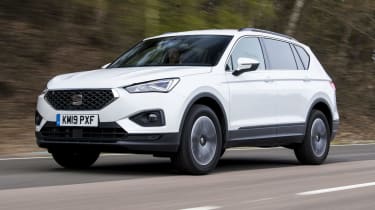
- Model: SEAT Tarraco 1.5 TSI SE Tech
- Price: £33,795
- Engine: 1.5-litre petrol, 148bhp
It looks different, but the Tarraco is almost identical to the Kodiaq under the skin. For that reason, we’d recommend finding the trim/engine combination that suits you best, and then find the SEAT or Skoda that offers the best value for money.
Used: Land Rover Discovery
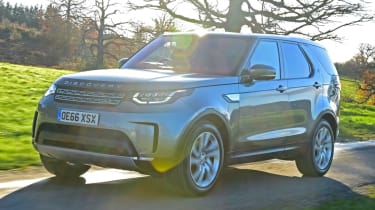
- Model: Land Rover Discovery 2.0 SD4 S
- Price: £34,500 (2017)
- Engine: 2.0-litre diesel, 237bhp
The 5008 and Kodiaq can fit seven at a pinch, but the Discovery has acres of space. It’s incredibly comfortable and the diesel has plenty of towing torque. The budget offers a wide range of choice, but we found a 2017 SD4 with 49,000 miles for less than £35k.
Figures
| Skoda Kodiaq 1.5 TSI SE L Executive | Peugeot 5008 PureTech 130 Allure Premium | |
| On the road price/total as tested | £35,575/£37,641 | £35,155/£36,405 |
| Residual value (after 3yrs/36k miles) | £20,498/57.6% | £18,565/52.8% |
| Depreciation | £15,077 | £16,590 |
| Annual tax liability std/higher rate | £2,517/£5,035 | £2,349/£4,698 |
| Annual fuel cost (12k/20k miles) | £2,144/£3,573 | £2,191/£3,652 |
| Insurance group/quote/VED | 19/£410/£155 | 20/£421/£155 |
| Service costs | £19/month (2yrs) | £16.28/month (3yrs) |
| Length/wheelbase | 4,699/2,790mm | 4,641/2,840mm |
| Height/width | 1,685/1,882mm | 1,646/1,844mm |
| Engine | 4cyl in-line/1,498cc | 3cyl in-line/1,199cc |
| Peak power/revs | 148/5,000 bhp/rpm | 129/5,500 bhp/rpm |
| Peak torque/revs | 250/1,500 Nm/rpm | 230/1,750 Nm/rpm |
| Transmission | 7-spd auto/fwd | 8-spd auto/fwd |
| Fuel tank capacity/spare wheel | 58 litres/repair kit | 56 litres/£217 |
| Boot capacity (7/5/2-seat modes) | 270/765/2,005 litres | 167/702/1,940 litres |
| Kerbweight/payload/towing weight | 1,569/615/1,800kg | 1,430/730/1,100kg |
| Turning circle | 11.6 metres | 11.2 metres |
| Basic warranty (miles)/recovery | 3 yrs (60,000)/3 yrs | 3yrs (60,000)/1yr |
| Driver Power manufacturer/dealer pos | 12th/14th | 11th/N/A |
| NCAP: Adult/child/ped./assist/stars | 92/77/71/54/5 (’17) | 86/85/67/58/5 (’16) |
| 0-62mph/top speed | 9.8 secs/126mph | 10.2 secs/117mph |
| Auto Express economy (mpg/mpl)/range | 37.0/8.1/472 miles | 36.2/7.9/446 miles |
| WLTP combined | 38.2-39.2mpg | 38.6-46.7mpg |
| WLTP combined | 8.4-8.6mpl | 8.5-10.2mpl |
| Actual/claimed CO2/tax bracket | 176/158g/km/36% | 180/151g/km/34% |
| Airbags/Isofix/parking sensors/camera | Yes/two/f&r/yes | Yes/three/f&r/yes |
| Auto box/lane keep/blindspot/AEB | £1,305/£435/£575/y | £1,610/yes/yes/yes |
| Climate ctrl/cruise | Yes/yes | Yes/yes |
| Leather/heated seats | Yes/yes | £1,300*/£1,300* |
| Metallic paint/LED lights | £610/yes | Yes/yes |
| Keyless entry & go/power tailgate | Yes/£215 | Yes/£400 |
| Sat-nav/digital dashboard | Yes/£405 | Yes/yes |
| DAB radio/connected services | Yes/yes | Yes/yes |
| Wireless charge/CarPlay/Android Auto | Yes/yes/yes | Yes/yes/yes |
